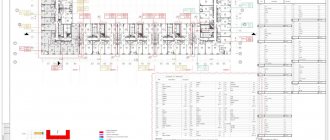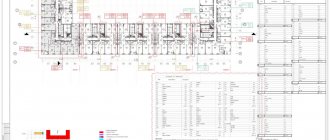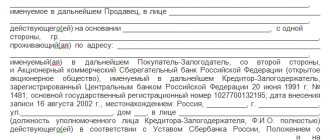Last update: 06/30/2020
All technical information about the apartment is expressed in a special document, which is used for cadastral registration of the property, accounting for structural changes in the property (after redevelopment, for example), as well as for reference purposes (for a bank, for example, in mortgage transactions).
Until 2013, only the Technical Passport , and since 2013 it has been supplemented by another document - Technical Apartment Plan . What is the difference between them?
The technical passport is used for reference and information purposes in various organizations, presenting detailed technical characteristics of the property, and the Technical Plan is used exclusively for cadastral registration of the same objects in the Cadastral Chamber of Rosreestr.
Both of these documents have a similar essence and composition, but differ in their purpose, data presentation format and some other details - more on that below.
Title documents for the apartment. What documents establish ownership – see the Glossary at the link.
Purpose of a technical passport for non-residential premises
According to current regulations, the production of a technical passport for non-residential premises is mandatory for any building on the territory of the Russian Federation. The law regulates not only the obligation to have this document, but also the specified standards for filling out the technical passport, information required to be reflected, its structure, etc.
The structure of the technical passport is presented on several pages:
- a title page containing a brief description of the object reflecting the exact address of its location and information about the owner;
- floor plan of the building or detailed layout of a separate office;
- general diagram of the building with highlighted boundaries;
- technical report, including assessment and quality of the condition of non-residential premises and the building as a whole;
- additional information about the owner.
The reasons for obtaining a technical passport may be different:
- change in the actual condition of the building, requiring adjustments to the document;
- updating information presented in the floor plan;
- registration of the redevelopment carried out;
- cadastral registration;
- concluding an agreement with a tenant to rent an office for a long time;
- planning the purchase or sale of a retail property
- and other reasons that led to the need to prepare technical documentation for the building.
Technical plan or technical passport: what to choose for state registration?
How not to get confused by similar names of documents and choose the one necessary for registration actions, explained in the cadastral chamber of the Yaroslavl region.
Technical passport is a document on the basis of which registration of residential buildings was carried out until 2012.
Important! A technical passport is not a title document. However, its scope is still wide. Data on changes after reconstruction or redevelopment are entered into it and used (copies are made) as a source of technical information about communications (electrical network, heating, sewerage, etc.) and equipment during design. Based on the passport, operational documentation is created. For example, to prepare for repairs.
“The passport contains the key parameters of the property. It records floor plans, locations of window and door openings, and communication diagrams. For example, a technical passport and its copies are used to coordinate construction and repairs,” explains expert of the Yaroslavl Cadastral Chamber Vladimir Fomin .
Since 2013, the basis for cadastral registration is the technical plan.
“The technical plan is a relatively new document, which for the purposes of state cadastral registration of capital construction projects. It replaced the technical passport,” says Vladimir Fomin.
The technical plan reproduces certain information entered into the Unified State Register of Real Estate, and indicates information about a building, structure, premises, an unfinished construction project or a single real estate complex necessary for the state cadastral registration of such a real estate object.
A technical plan is required in the case of the initial registration of an object for cadastral registration, to take into account changes in information about the object, to take into account changes in information about parts of the object (formation of a new part), to put the object into operation.
Primary registration implies accounting for a newly created property. Accounting for changes in information is carried out when one of the unique characteristics of the object changes (area, layout, purpose, etc.).
“Information in the technical plan is included on the basis of the cadastral work of the building design documentation submitted by the customer, a construction permit, a permit to put the building into operation, or a technical passport of the building produced before January 1, 2013,” the expert emphasizes.
The document is prepared by a cadastral engineer. He visits your property and takes the necessary measurements. Next, it forms a technical plan, which includes a graphic and text part.
The technical plan, drawn up in accordance with current legislation, is transferred to the customer on an electronic medium signed by a cadastral engineer for submission to Rosreestr.
“Despite the apparent identity of the technical passport and technical plan, they not only differ in content, but also serve different purposes. The technical plan includes the ability to determine the location of the property. Therefore, unlike a technical passport, a technical plan in its graphic part will contain a drawing that includes the numbering of turning points, as well as documents defining the location of the object within the boundaries of the land plot,” notes Vladimir Fomin.
The validity period of the technical plan, like the validity period of the technical passport, has no restrictions. The documents are relevant as long as the technical condition of the property has not changed.
Documents for obtaining a registration certificate
Obtaining a technical passport for non-residential premises begins with collecting a complete set of documents, the list of which is regulated at the federal level. There are four names on the mandatory list:
- identification document of the applicant;
- documents establishing the owner's right to the object;
- application for registration of a technical passport;
- document confirming payment of the state duty.
Depending on the conditions of a particular situation, this list may be expanded by an additional list of documents. So, when issuing a technical passport, the subtenant will need his passport, sublease agreement, power of attorney to act in the interests and on behalf of the owner, etc. Employees responsible for technical inventory have the right to request a conclusion from the sanitary and epidemiological station, fire inspection and gas service.
Who can apply for a technical passport?
Both the owner and a person who has a power of attorney certified by a notary to carry out the registration process can submit the necessary documents in order to obtain a technical passport of a building or premises.
For reference! Obtaining a technical passport is a long and labor-intensive process that includes many nuances. For this reason, many owners of non-residential premises prefer to seek help from agencies and bureaus that provide assistance in preparing documentation.
Turning to specialists for help allows the owner or tenant to save their time. In addition, a professional approach guarantees compliance with all rules and regulations established by law.
Where to submit documents and where to get a registration certificate?
The preparation of technical certificates for buildings and non-residential premises, as well as for houses and apartments, is carried out by employees of the Bureau of Technical Inventory (BTI). Along with the application, the technician accepts the original documents, reads them and makes copies, returning the documents themselves to the applicant. Each copy is certified by an employee, and the process of producing a registration certificate can be considered launched.
Having received the document, you should take care of its safety, since the validity period of the technical passport for non-residential premises is established until actual changes are made to the reflected information. Reconstruction, redevelopment, construction of an extension is a reason to start the procedure from the very beginning. You cannot make amendments yourself; this is the direct functionality of BTI employees.
Validity
The law does not establish a time frame for the relevance of the technical passport of non-residential premises. The document is valid until changes are made to the actual state of the object. In this case, the previous registration certificate is considered outdated and updating it or obtaining a new document is a prerequisite.
Attention!
Our articles talk about typical ways to resolve legal issues, but each case is unique. If you want to find out how to solve your particular problem, call: +7(499) 703-42-21 - Moscow +7(812) 309-91-17 - St. Petersburg +7(800) 500-27- 29 ext. 482 - Russia (general) or if it is more convenient for you, use the online consultant form below! All consultations with lawyers are free.
Is the presence of the owner required?
Russian legislation allows this option of submitting documents and conducting the necessary examinations when the owner of the premises is not present. Instead, a representative acts, whose right is confirmed by an appropriate notarized power of attorney.
The length and complexity of obtaining a registration certificate, coupled with the legal nuances of a specific situation, is the main reason for owners of non-residential premises to seek qualified assistance from specialized bureaus and agencies. The owner saves his time and receives a guarantee of compliance with all legal norms and rules.
Duration of the procedure for producing a registration certificate
According to federal regulations, issuing a technical passport for an office, garage or industrial facility should not take more than 14 days from the date of submission of documents to the BTI. In fact, this period can extend significantly due to objective and subjective circumstances:
- bureaucratic red tape;
- the applicant is not aware of the sequence of actions;
- an incomplete set of documents is provided;
- and other reasons that prevent compliance with the deadline regulated by law.
Duration of validity of the technical passport
The relevance of a technical passport for objects of the non-residential real estate sector is not limited by strict time frames. It is valid as long as the information reflected in it corresponds to the real state of affairs. Any changes in area, floor material, location of premises, change of owner must be immediately reflected in the new edition of the technical passport. For this, a corresponding set of documents is being prepared, with which you should contact the Technical Inventory Bureau again, and the procedure will be repeated from the beginning.
♦ What does the technical passport of the apartment look like ♦
Previously (before 03/01/2008 – the year the State Property Committee was created), a Technical Passport was required for registration actions in transactions with apartments. Now, for the purchase and sale of an apartment, a Cadastral passport is used - more precisely, electronic data of cadastral registration of an apartment , which is contained in the unified database of the Unified State Register of Real Estate.
A Technical passport , due to the fact that it contains detailed technical characteristics of both the apartment (premises) itself and the entire house (building) as a whole, may be required in the following cases:
- at the request of the creditor bank (when purchasing housing with a mortgage);
- at the request of the insurance company (when insuring the title or the property itself);
- at the request of the Guardianship and Trusteeship Authorities (in the case of a transaction involving a minor child);
- at the request of a notary (in the case of registering an apartment as an inheritance, for example);
- at the request of the court (in case of challenging the rights to the apartment);
- for the preparation of a Technical Plan (for the purpose of registering the apartment for cadastral registration).
Apartment vs. Apartments. What is better and more profitable to buy? – see the link.








